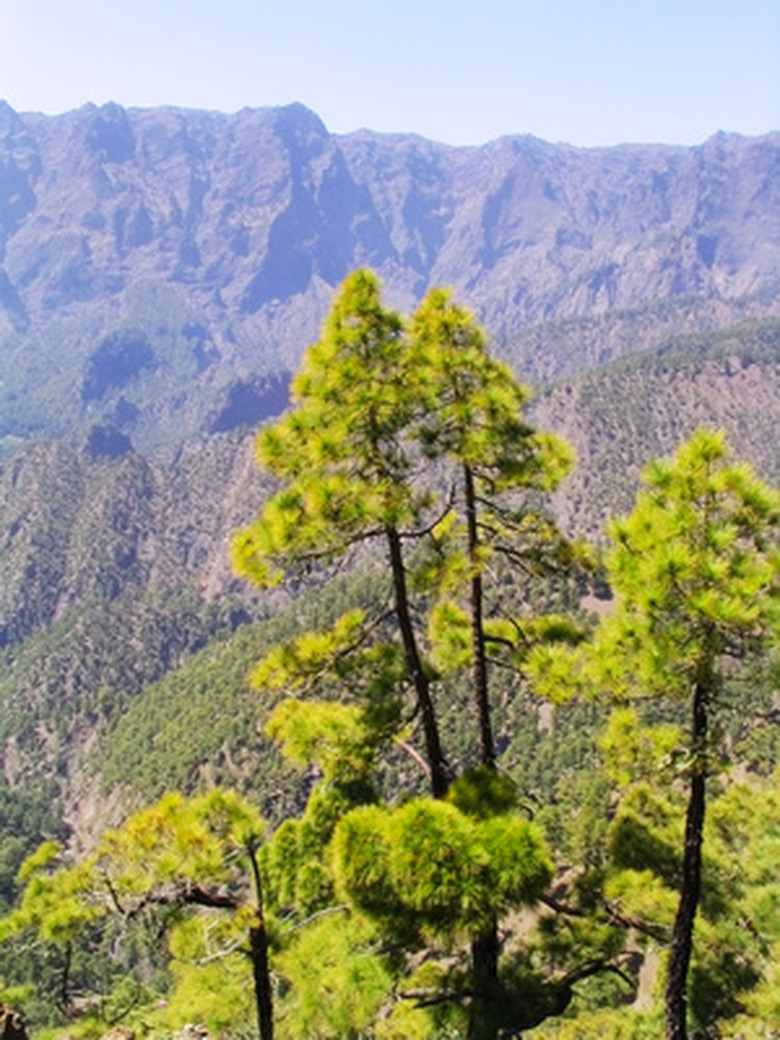The Different Types Of Evergreen Trees
Trees that have the ability to retain their foliage year-round are evergreen species, with most of those in North America classified as conifers. These trees bear cones in which naked seeds exist and have needles in most cases, which finally fall off when replacements grow. The evergreen trees are in different families, with each grouping possessing some different characteristics.
Pines
The pines fall under the category of either soft pine or hard pine, a reference to the texture of their wood. As many as 35 different kinds grow in Canada, the United States and Mexico. At least one type of pine is native to every state in the continental United States with the sole exception being Kansas. Pines typically grow in acidic soil and are among the first trees to sprout up after a fire has cleared an area. The soft pines have needles that usually grow in bundles of fives on the twigs, while the hard pines have bundles of needles in threes and twos. Some pines, such as the sugar pine, can grow to be more than 200 feet tall. Others, like the pinyon pines of the Southwest, rarely exceed 50 feet. More kinds of pines grow in the northern states with cooler climates, as this is true with most of the evergreen conifers. Pines are important timber trees and useful for landscaping purposes. The fact that they can exist in poor quality soils makes them attractive to property owners.
- Trees that have the ability to retain their foliage year-round are evergreen species, with most of those in North America classified as conifers.
- More kinds of pines grow in the northern states with cooler climates, as this is true with most of the evergreen conifers.
Hemlocks
Of the 10 hemlock species that exist worldwide, four occur in North America. Hemlock grows in the Pacific Northwest, the Northeast and in the mountains of the Mid-Atlantic States. Hemlocks have a pyramidal shape, and landscapers often include them on property as screens and windbreaks. These slow-growing trees have short needles that develop in two rows on the twig. Hemlocks do much better in the shade than in the full sun. The hemlocks generally do not tolerate dry settings. The western hemlock is easily the largest of the American species, growing to heights approaching 200 feet and having a trunk 4 feet in diameter. The most widely distributed hemlock is the eastern hemlock, which grows around the Great Lakes, through the Appalachians, into New England and across eastern parts of southern Canada.
- Of the 10 hemlock species that exist worldwide, four occur in North America.
- The western hemlock is easily the largest of the American species, growing to heights approaching 200 feet and having a trunk 4 feet in diameter.
True Firs
True fir trees include species such as the balsam fir, white fir and subalpine fir. Of the nine types that grow in North America, these three have the largest ranges. True firs feature compact cones that emerge upright on the limbs and often grow at the top part of the tree. The true firs are among the most popular types of trees utilized as Christmas trees and equally fashionable as ornamentals. True firs are excellent as a standing specimen tree or in groves and in rows, forming screens and windbreaks. The different species grow under an array of soil conditions. The tallest of the true firs is the balsam fir, which averages between 40 and 60 feet high, while the bristlecone fir, noble fir, California red fir, grand fir and Pacific silver fir can all exceed 150 feet high.
- True fir trees include species such as the balsam fir, white fir and subalpine fir.
- The true firs are among the most popular types of trees utilized as Christmas trees and equally fashionable as ornamentals.
References
- "Trees of North America"; C. Frank Brockman; 1996
- "National Audubon Society Field Guide to Trees"; Elbert L. Little; 2008
